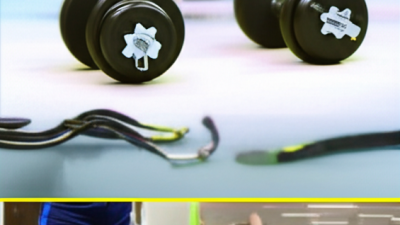
-
Home
-
Products
-
About Us
-
News
-
Contact Us
Leave Your Message

When it comes to crafting a successful fitness regimen, one pivotal aspect often overlooked is selecting the right Dumbbell Weights. According to a report from the American College of Sports Medicine, strength training should be a core component of any exercise plan, as it not only builds muscle but also enhances metabolic rate and improves overall health. With nearly 60% of Americans engaged in some form of resistance training, the decision on which dumbbell weights to use becomes crucial for aligning workouts with personal fitness goals.

Whether you are aiming to build muscle, lose weight, or simply maintain your current fitness level, understanding how to choose the appropriate dumbbell weights can significantly impact your results and prevent injury. This article will explore five essential tips to help you make informed choices that align with your aspirations and enhance your fitness journey.
Selecting the right dumbbell weights is crucial for effectively reaching your fitness goals. Understanding your specific objectives—whether it's building strength, increasing muscle endurance, or improving overall fitness—can significantly influence your choice. For example, if your goal is to build muscle mass, you'll want heavier weights that challenge your muscles, typically in the range of 70-85% of your one-rep max. This intensity promotes hypertrophy, allowing your muscles to grow and adapt over time.
On the other hand, if your focus is on enhancing endurance, lighter weights with higher repetitions may be more beneficial. Using weights that are around 50-65% of your one-rep max can help improve your muscular endurance, allowing you to perform longer workouts without fatigue. Also, consider your experience level; beginners may benefit from starting with lighter dumbbells to master form and technique, gradually increasing the weights as their strength improves. By aligning your weight selection with your fitness goals, you can maximize your workout effectiveness and achieve your desired results efficiently.
Progressive overload is a fundamental principle in strength training that involves gradually increasing the stress placed on your muscles during workouts. According to a report by the American College of Sports Medicine, consistently applying progressive overload is essential for maximizing muscle gain and strength. By steadily increasing your dumbbell weights, you challenge your muscles to adapt, leading to improved strength and hypertrophy.
When selecting dumbbell weights, it's crucial to choose weights that are heavy enough to create a challenge but allow you to maintain proper form. For beginners, a good starting point is selecting dumbbells that you can lift for 8-12 repetitions with moderate difficulty. This aligns with the National Strength and Conditioning Association guidelines, which emphasize rep ranges for optimal muscle growth.
Another essential tip is to regularly assess your progress and adjust your weights accordingly. As your strength improves, incrementally increase your dumbbell weights to continue stimulating muscle growth. Over time, even small adjustments can lead to significant gains, reinforcing the need for a personalized approach to weight selection that aligns with your fitness goals and progressive overload principles.
This chart illustrates the progressive overload principle by showing muscle gain measured in pounds over a period of six weeks. As the training intensity increases weekly, the muscle gain also progressively increases, highlighting the importance of gradually increasing weights to maximize strength and muscle growth.
When it comes to selecting the right dumbbell weights for your fitness goals, research-backed methodologies provide a strong foundation for decision-making. The first step is to assess your current fitness level and define your objectives: are you looking to tone up, gain strength, or build muscle mass? Understanding your starting point can help in choosing the appropriate weight that neither overwhelms you nor fails to challenge you during workouts.
A general guideline suggests that beginners start with a weight that allows them to perform 10-15 repetitions of an exercise with good form. After completing this, you can adjust the weight based on your comfort and fatigue levels. Additionally, the principle of progressive overload should be applied; gradually increasing the weight as you get stronger promotes continuous improvement. Tracking your progress through a workout log can further enhance your decision-making by ensuring you are consistently challenging yourself while staying aligned with your fitness objectives.
Engaging with a qualified fitness professional can also deliver personalized insights tailored to your unique needs and goals, making your journey toward fitness more effective and enjoyable.
When selecting dumbbell weights for your fitness journey, the material and design of the dumbbells play a crucial role in performance and effectiveness. Different materials, such as rubber, vinyl, and metal, each offer unique benefits. Rubber-coated dumbbells, for example, provide a non-slip grip and protect the flooring, making them ideal for home gyms. In contrast, metal dumbbells are often more durable and can be more appealing for serious weightlifters due to their classic look and feel.
The design of the dumbbells also significantly impacts functionality. Adjustable dumbbells can be a game-changer, allowing users to modify weights easily and adapt their workouts as they progress. Additionally, ergonomic designs with contoured grips help reduce strain on the wrists and hands, ensuring a more comfortable lifting experience. Prioritizing these factors when choosing your dumbbells can enhance your workout efficiency and help you stay committed to your fitness goals.
| Criteria | Description | Importance |
|---|---|---|
| Weight Range | Select a range that suits your fitness level and goals, whether for strength training or hypertrophy. | High |
| Material | Common materials include rubber, neoprene, and metal, each offering different benefits in grip and durability. | Medium |
| Design | Ergonomic designs enhance comfort during workouts, reducing the risk of injury. | High |
| Adjustability | Adjustable weights allow users to easily change resistance for different exercises. | High |
| Grip | A non-slip grip is essential for maintaining control during lifts and preventing accidents. | High |
When aiming for effective weight training, most people instinctively reach for dumbbells. However, exploring alternatives like resistance bands and kettlebells can enhance your workout routine and target different muscle groups more effectively. Resistance bands are incredibly versatile and can be easily adjusted for varied resistance levels, making them ideal for both beginners and advanced users. They also offer the advantage of portability, allowing you to incorporate them into any workout regimen, whether at home or on the go.
Kettlebells, on the other hand, provide a unique advantage with their design, enabling dynamic movements that engage multiple muscle groups simultaneously. Exercises like swings, cleans, and snatches not only build strength but also improve cardiovascular fitness and coordination. Integrating kettlebells into your training can elevate your workouts by introducing functional movements that mimic real-life activities.
By diversifying your training tools with resistance bands and kettlebells, you can keep your fitness journey exciting and dynamic, ensuring continuous progress toward your fitness goals.